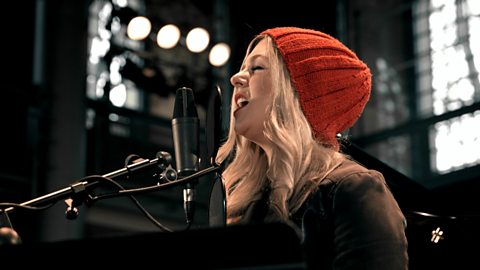Sentences
Different types of sentence suit different purposes. Using a variety of sentence types is a key factor to effective writing.
Words, phrases and clauses
Words
A sentence is made up of words put together to do a certain job. Words are the smallest meaningful units of a sentence.
For example:
barks / dog / angry
Each of the above words work differently in a sentence:
- barks is a verb – a word type that tells what a noun is doing or being
- dog is a noun – a word type that names people, places, things and ideas
- angry is an adjective – a word type that describes a noun
Words are linked to create a phrase to build up the sentence.
Phrases
A phrase is used in place of a word to give more information about it. A noun phrase is built around a noun, making the noun the head word of a noun phrase.
For example:
The angry dog.
In this noun phrase, the noun ‘dog’ is the head word.
A phrase that comes immediately before a verb is the verb’s subject. A phrase that follows a verb is the verb’s object.
- The angry dog barks. – 'dog' is the subject
- The angry dog barks at the postman at the door. – 'postman' is the object
Phrases are linked to a main verb to make a clause.
Clauses
A clause is one or more phrases linked to a verb that work very tightly together.
For example:
The angry dog barks.
In this clause - which could also be used as a sentence - the noun phrase is 'the angry dog' and the verb is 'barks'. The head word of the noun phrase is the noun ‘dog’.
Simple sentences
If there is a capital letter at the beginning of a clause and a full stop at the end, you have a sentence.
For example:
The angry dog barks.
This is a simple sentence. A simple sentence consists of one clause that has a subject and a verb.
A simple sentence puts across one simple idea. For example:
Rebecca sang.
There can also be several words in the verb. An example of a sentence with two words in the verb is:
It was raining.
An example of a sentence with three words in the verb is:
Sean has been running.
In each of the examples there is just one main verb and one idea. This is the simplest type of sentence and is usually very easy to understand.
Compound sentences
A compound sentence has at least two two major independent clauses.They can be joined by a semicolon, or a comma and coordinating conjunction, such as 'and', 'or' and 'but'.
For example:
- It was cold, but we still went to town.
- It was raining, and we stayed indoors.
This makes the two ideas equal in the sentence - if you take away one part of it, you are left with a simple sentence again. These are very common when speaking and they are not difficult to understand.
Here are three more examples of compound sentences with the connectives written in bold:
- The couple walked down the road, and their neighbours waved from the house.
- The dog came rushing in, so the cat ran upstairs.
- My friend gave me a lift, because it was raining.
One advantage of compound sentences is that a writer can build more detail into their writing. However, one problem is that some writers can get carried away and write long rambling sentences.
For example:
My friend came round and said, "Do you want to get out of the house for a while?" and I did so we went to town and walked around for a bit and then some women came over who we knew from work so we started talking to them and then we felt hungry so we…
Remember, care needs to be taken when using connectives. Two in a sentence is usually enough, and they don't need to be used in every sentence.
Fragments
Sometimes writers don't use full sentences. Sentence fragments often help to emphasise a point, create drama or show surprise, but they are not complete sentences:
- She looked as carefully as she could, but found nothing. Absolutely nothing.
- Imagine this. You're trapped. It's dark. It's cold.
Try to consider how you can add impact to your own writing by using fragments instead of full sentences.
Complex sentences
A complex sentence communicates more than one idea, so it is like a compound sentence in a way. However, the ideas are not equal. This is because one part is like a simple sentence, so it can stand on its own. The other part can't - it needs something else to support it.
For instance, look at this sentence:
You can't persuade me to go to town, no matter how hard you try.
The first part could be a simple sentence - it stands on its own. However, the second part, 'no matter how hard you try', is not a simple sentence and it doesn't stand on its own. It needs something else to make sense.
We use complex sentences a lot when we speak, but it's important to use them in your writing too.
These are the most difficult sentences to get right.
Here is another example:
When I arrived the angry dog barked.
The main clause is 'the angry dog barked' because it has a subject and a verb and makes sense by itself.
The minor clause is 'When I arrived''. Although it is a clause with a subject and a verb, it doesn't make sense on its own. It needs a main clause.
You can add more minor clauses to make a more complex sentence.
When I arrived the angry dog barked because it was hungry.
Purpose of sentences
Sentences can be thought about in terms of their purpose. For example:
Statements
Statements tell us things.
These tend to be in school text books, in newspapers, or in an encyclopedia.
For example:
- Paris is the capital of France.
- Manchester United play at Old Trafford.
- There are seven days in a week.
Questions
Questions ask us about something, or make us think about things.
For example:
- What does TiPToP stand for?
- When did the First World War end?
- How much for a coffee?
Orders
Orders are also called commands. These tell us what to do, and are found in instructions, recipes and signs.
For example:
- Put your litter in the bin.
- Do not touch.
- Next, take a small pinch of salt and mix it all together.
Exclamations
Exclamations are shouted out. You would hear these at a sporting event, in arguments, or if you told a joke.
For example:
- Amazing!
- Shut up!
- Goal!
Variety of sentences
It is good to have a variety of sentences in your writing.
You can have short ones, and then some long ones… But as we have already seen, if they are all simple sentences, it gets boring and difficult to read. You should also use a mixture of questions and statements.
Imagine that you have been asked to give some advice to a friend who is being bullied. You would probably think of a few ideas very quickly:
- Tell your family about it.
- Don't suffer in silence.
- Do something about it.
You could improve your work by adding other types of sentences. At the moment, it is just a list of orders. You could add questions, such as:
- Why don't you talk to someone at school about it?
- Do you know anyone else who is being bullied right now?
- This pushes your friend to think about something.
It also gives them the opportunity to start talking about it.
Then you could add a statement or two, such as:
- Bullying is more common than many people think.
- The worst thing about being bullied is feeling alone.
If you combine these ideas and sentences, you will have an interesting and varied piece of writing. All you need to add are some connectives, such as 'and', 'but', 'so' or 'because'. Now you have writing that makes a real impact and which can offer advice as well as persuading people.
Here is an example:
Do you know anyone else who is being bullied right now? Why don't you talk to someone at school about it? Bullying is far more common than many people think and far more serious than many people imagine. In fact, it is one of the main reasons for pupils missing school. But the worst thing about being bullied is feeling alone. So don't suffer in silence, tell your family about it and do something now.
Variety of sentences task
You can see why variety is important by looking at this list below. It is taken from a story called You are now entering the human heart, by Janet Frame, and is actually one of her paragraphs broken down into simple sentences:
Her eyes faced the lighted exit.
I saw her fear.
The children were sitting down.
None of them had ever touched a live snake.
They were hushed with fear.
They were waiting for the drama to begin.
One or two looked afraid.
The attendant took a green snake out of a basket.
It was about three feet long.
He made a swift movement.
He draped the snake around the teacher's neck.
She did not have a chance to protest.
He stepped back to admire the sight.
He looked satisfied.
It doesn't really sound right. How could the writer change this to convey the drama of the situation? Look again at the sentences and decide what changes you could make, which ones you could join. Then reveal the version from the book below and compare your ideas.
'Her eyes faced the lighted exit. I saw her fear. The children, none of whom had ever touched a live snake, were sitting hushed, waiting for the drama to begin; one or two looked afraid, as the attendant withdrew a green snake about three feet long from the basket and with a swift movement, before the teacher could protest, draped it around her neck and stepped back, admiring and satisfied.'
You are now entering the human heart by Janet Frame
More on Writing skills
Find out more by working through a topic
- count3 of 7

- count5 of 7

- count6 of 7
